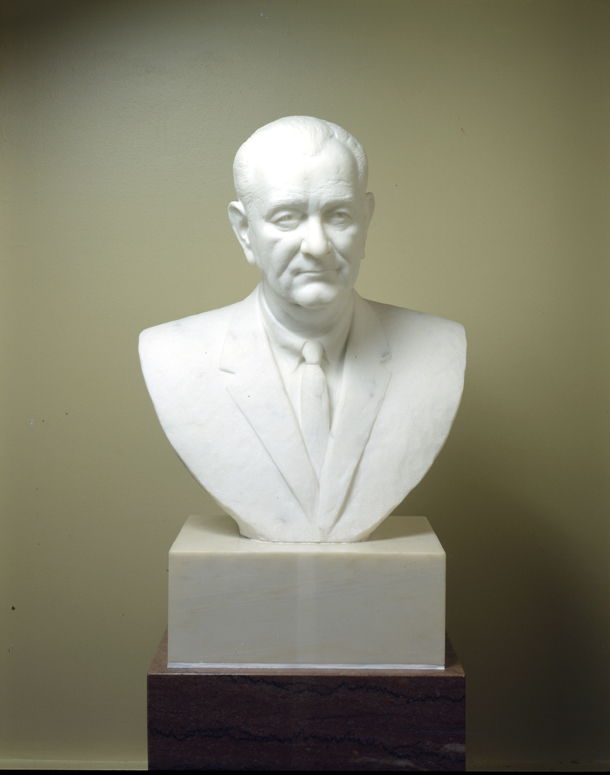
| Title | Lyndon B. Johnson |
| Artist/Maker | JIMILU mason ( 1930 - 2019 ) |
| Date | 1966 |
| Medium | Marble |
| Dimensions | h. 24.5 x w. 20.75 x d. 12.75 in. (h. 62.2 x w. 52.7 x d. 32.4 cm) |
| Credit Line | U.S. Senate Collection |
| Accession Number | 22.00037.000 |
In 1959, finding it impossible to persuade Lyndon Johnson to slow down and pose for her, sculptor JIMILU mason of Alexandria, Virginia, used photographs, as well as her memory and imagination, to create a small bronze caricature of the statesman when he was Senate majority leader. The humorous piece, titled On the Run, depicted Johnson in frenzied motion, with a telephone to his ear. Soon afterward, JIMILU received a second challenge: to sculpt a bust of Johnson to serve as the prize in a congressional bet regarding a baseball season opener. For this bust, Johnson permitted JIMILU occasional sittings over the next six years as he became vice president and then president. These sittings took place primarily at the White House, though on one occasion the work was transported via Air Force One to Texas, where the artist continued the modeling at Johnson’s ranch. Commenting on the sittings at the White House, JIMILU wrote:
It is unusual for anyone to understand how difficult it is to
sit for a portrait
. It is hard work and often a surprise as to what is required. President Johnson was no different. I believe he thought it was enough for me just to be in the same room.... At first the many visitors were distracting and it was almost impossible to keep him still. Finally, I realized that it was the visitors who were keeping him animated, making it possible for me to focus on my work.
JIMILU’s clay model was cast in plaster, then in bronze. John Walker, who was then director of the National Gallery of Art in Washington, D.C., termed the bronze bust “an excellent likeness with a very lively surface.” 1 Though Johnson was reported by the Associated Press to have quipped to JIMILU, “I must say you certainly got the large Johnson ears,” he actually considered the finished bronze bust a favorite likeness. 2 So pleased was he, in fact, that he presented miniature copies in simulated bronze to close friends and various heads of state.
Shortly after the bronze bust was completed, Johnson selected JIMILU to execute his portrait for the Senate’s Vice Presidential Bust Collection. Using the existing bronze as her model, JIMILU traveled to Italy where she oversaw translation of the piece into Carrara marble. The Senate accepted the completed work in July 1966, but it was not placed in the Senate wing of the Capitol until May 1979 when the bust of his predecessor, Vice President Richard M. Nixon, was also installed. The sculptor’s earlier bronze model for the marble bust is displayed at the Lyndon B. Johnson Library in Austin, Texas, as is her caricature On the Run. JIMILU also executed the bust of Constantino Brumidi in the Senate. Her other portrait works include the official bust of United States Chief Justice Frederick M. Vinson and a bust of Chief Justice John Jay, both in the collection of the Supreme Court of the United States; and life-size busts of author William Faulkner at Fisk University in Nashville, Tennessee, Senator Richard Russell at the University of Georgia in Athens, and Senator John C. Stennis at the John C. Stennis Space Center in Hancock County, Mississippi.
1. Agnes E. Vaghi, “The President Gets a Bust,” Washington, D.C. Sunday Star, 24 April 1966.
2. ”Sculpture Gets Head Start: Bronze Wins Presidential Approval,” Washington Post, 7 January 1967.
As 36th president of the United States, Lyndon Baines Johnson pushed through Congress more major legislation than had been passed during any presidential term since Franklin D. Roosevelt's New Deal.
Born near Stonewall, Texas, Johnson was appointed that state's director of the National Youth Administration by Roosevelt in 1935. Johnson held this position for two years until winning a special election to fill a vacancy from Texas in the U.S. House of Representatives. A Democrat, he was reelected five times and served until 1949, when he became a U.S. senator. Johnson became Democratic whip in 1951 and floor leader in 1953. He lost a bid for the Democratic nomination for president in 1960 but accepted John F. Kennedy's offer to be his running mate. Elected 37th vice president, Johnson promoted the president's programs and served as chairman of the National Aeronautics and Space Council and the President's Committee on Equal Employment Opportunities.
Following Kennedy's assassination on November 22, 1963, Johnson assumed the presidency. Committed to carrying forth the late president's programs, Johnson actively supported passage in Congress of the groundbreaking Civil Rights Act of 1964. He outlined an extensive program of economic and social welfare legislation designed to fight poverty and create what he called "The Great Society." Elected president in 1964, he worked zealously for reform, engineering passage of Medicare legislation, the Voting Rights Act of 1965, funds for his War on Poverty, and other legislation. Domestic achievements, however, were soon overshadowed in the public mind by the country's role in the Vietnam War. Johnson did not seek reelection in 1968. He retired to his ranch in Stonewall, Texas, where he died in 1973.